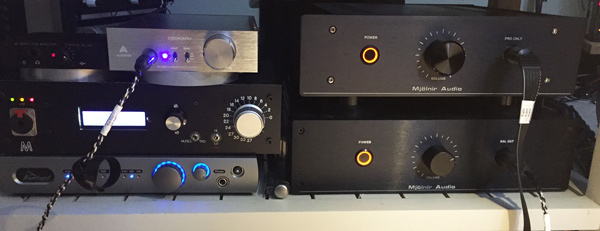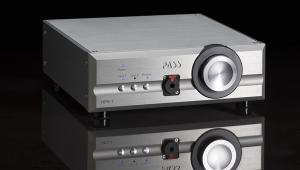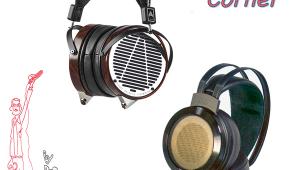| Columns Retired Columns & Blogs |
Katz's Corner Episode 21: How Insensitive! Part 2

This story originally appeared at InnerFidelity.com
The Listening...or...Rumble in the Jungle
As you may recall, in Episode 20, I proposed that headphone amplifier's output levels and headphone sensitivities should all be reported in dBu. dBu enables any consumer to quickly predict the SPL of various headphones with the various amplifiers, without needing to use algebra or logarithms. They can simply add or subtract to arrive at a basic assessment of the output level (drive) capability of the amplifier matched with the headphone and the potential impact of amplifier noise.
So today we'll pick up on this principle and briefly compare the sound qualities of six very different headphone amplifiers, concentrating on their headroom, impact, perceived loudness, detail, and depth. Then, in the next episode, I'll try to make sense of the listening and see if there is any correlation between what we measure and what we hear. Don't expect a miracle—listening versus measurements is an ongoing debate, but in Episode 22 I promise to reveal some tantalizing clues!

Fig. 1. Amplifier Jungle. From left to right, top row: JDS Labs O2, Audeze Deckard, Mjolnir KGSS Carbon HV. Middle row: AMB M3 (Katz custom build), Mjolnir Pure Bipolar. Bottom Left: Prism Callia DAC/Amp.
My headphone amplifier jungle is currently packed with six pieces: The JDS Labs O2, an inexpensive contender, using integrated circuit topology, powered by a wall wart. Next, the Audeze Deckard, a high-end DAC integrated with a high-powered discrete Class A amplifier. It also makes a wonderful standalone headphone amplifier with available RCA line inputs. I currently am not using the Deckard's DAC and I feed a separate DAC to all the amplifiers. Next, the Mjolnir Audio KGSS HV Carbon, feeding the Stax SR-007 Mk2 electrostatic headphones. This amplifier is discrete, fully-balanced input to output, using SiC FET (silicon carbide field effect transistors) output devices that Mjolnir claims are as close to triodes as solid-state can get.
Next row, left, the AMB M3 amplifier, unbalanced in and out, custom-built by yours truly using selected parts and the highest voltage AMB discrete power supply. In this M3 I've installed a specially-biased Burr Brown OPA-627 input opamp which feeds its MOSFET output transistors. Next, the Mjolnir Pure Bipolar amplifier, also fully balanced and symmetrical from input to output, biased in Class A. Last but not least, the Prism Callia DAC, which includes a built-in headphone amplifier. The Prism is a high-precision audiophile DAC that supports multiple sample rates including DSD, with both SPDIF and USB inputs. I am not familiar with the topology of its build in headphone amplifier, but we can listen to it and in the next episode measure its basic performance.
In this listening comparison, I'm concentrating on headroom and impact, and secondarily, any obvious differences in reproduced depth, separation and tonality of each amplifier. I cannot possibly do a thorough review of six amplifiers in such a short time: this is meant to be a refresher, and besides, I've given detailed reviews of several of these amps in past episodes. If you believe that all amplifiers sound the same because blind tests have not been able to reveal sonic differences, then stop reading right now, because this is not a blind test. It's as formal and controlled a sighted listening test as I know how to do, using a single musical reference that I know intimately.
First, I matched the voltage levels of each amplifier to less than 0.1 dB, if possible, with a 110 ohm resistive load. The volume control of one of the amps, the O2, was not precise enough to maintain 0.1 dB channel match at the desired gain, and it ended up correct on one channel and about 0.2 dB off on the other. Even an 0.1 dB level difference can present apparent sonic differences. The only exception to the measured level match was the Stax amp, which I had to adjust by ear, because it uses a completely different voltage system. Switching the LCD-4s between the balanced and unbalanced amplifiers is a job that takes about a minute to exchange headphone cables, so this is definitely not an instant A/B comparison.
I left all the analog controls in their matched gains, and adjusted overall volume with the 64-bit precision digital volume control in Acourate Convolver, which is dithered to 24 bits on the way to the DAC. I listened to the music at a level of about 83 dB on fortes, which is loud but not overbearing. At this level it's easy to judge the impact and strength of this rhythmic jazz piece and the potential of each amplifier to deliver this impact. For dynamic headphones I chose the Audeze LCD-4, and for electrostatic the Omega Mk2, formally called the SR-007 Mk2. Each headphone received its Katz custom EQ within Acourate Convolver. To keep the loading on the Callia very high impedance, I fed a maximum of two unbalanced amps in parallel at any time from its unbalanced outputs, and two balanced amps in parallel from its balanced outputs. So sometimes I had to move input cables to feed a different amplifier.
Listening: AMB M3
The music is by Lindsey Webster, from her smooth jazz album "Back To Your Heart", which was a Billboard top single. I'm intimately familiar with recording, which I mastered, so it makes an excellent reference. I'm playing the 24/96 master.
Starting with the AMB, I notice Lindsey's voice is clear, moderately warm, but on the dry side compared with my reference loudspeakers. The bass instrument is tight, but not very fat, and I believe it should sound fatter based on the reference loudspeakers and how I mastered this recording. There's good depth in the sonic picture: the AMB has definitely got some three-dimensionality, with the sound extending beyond the headphones developing an image outside the left and right ears, creating a virtual stage that's wider than my head. The high frequencies are a bit etched, making the sound a bit on the bright side. The snare has good, strong impact and there is no impression that the amplifier is running out of steam, so the dynamics are definitely moving and the overall sound is punchy. Detail is clear, revealing. I brought this amplifier and the Prism DAC to Tyll's Big Sound shootout in Boseman, and it wiped out all but one of the commercial contenders.
Listening: JDS Labs O2
I haven't listened to the O2 amp in about a year, so this amounts to a new get-acquainted opportunity. Switching to the O2, I immediately notice the sound is thicker, a bit mushy, but this results in a warmer tonality for Lindsey's voice that I do prefer. The O2 gives her voice apparently more body, but maybe that is just due to the overall mushy feeling. The overall sonic detail is a bit obscured compared to the AMB. The snare drum does not have nearly as much snap on the O2, but most obvious, there is a loss of depth, which has become seriously constricted.
Every instrument and vocal has moved forward, creating a planar picture instead of a curved one. I know that the sonic picture is supposed to be curved with the instruments, background vocals, and ambience forming a dimensional U shape and her voice centered and up front. I helped create that sound during the mastering, and I know the tools mixing engineer Mark Gray used to help create that image during the mixing. Although this is a multi-miked recording, many of the instruments were recorded with stereo miking, and many of the mixing tools which were used create a believable acoustic space. While we can't expect headphones to have the big, deep soundstage that speakers can produce, I do believe that circumaural headphones can reproduce a great deal of depth if given the opportunity.
With the O2, I feel the sticks on the cymbals have lost some of their attack. Overall this is not a very detailed amplifier, dynamics seem a bit constricted. Yes, it can play just as loudly as the AMB, but its microdynamics on peaks sound constricted to me. Is this due to clipping, or is it something else? In summary, this amp sounds much too forward, flat, unidimensional. Everything is in your face, there's little or no differentiation between the depth and distance of the vocals and instruments.
Listening: Audeze Deckard
Switching to the Deckard from the O2, I immediately notice the return of three-dimensionality. On the Deckard, the snare has more impact and snap and far more impacting microdynamics than the previous two amps. Lindsey's micromovements, her crescendi and decrescendi, are more obvious...and entertaining. Tonally in the lower midrange and bottom, the Deckard is more similar to the O2 than the AMB; it is warmer than the AMB, but it doesn't have the mud or loss of detail in the lower midrange and bottom compared with the O2.
In the upper midrange and top the Deckard is more detailed without sounding fatiguing. Once again I can feel the sticks on the cymbals, but without the harshness that I noticed in the AMB. The Deckard's dimensionality is moderate, perhaps a little less than the AMB, but not significantly. The overall tonality of the Deckard's sound is far more musical and 3-D than it was with the O2. There's more solidity and the sound is more lively than it was with either of the predecessors.
Listening: Prism Callia Integrated Headphone Amp
Switching to the headphone amp integrated in the Callia DAC, suddenly, the sound has shrunk, it's much smaller than with any of the three predecessors. Sadly, the overall sound quality is a pastiche of this music. This is not a high-quality headphone amp and I feel should only be used for a quick reference if nothing else is available. Yes, it can deliver the level that the LCD-4s need, but it doesn't have the separation, depth or definition. It's also bright on the high end, perhaps because the other ranges are so muddy. The sound of this headphone amp belies the incredible high quality of the Prism DAC itself, so Callia buyers should consider its headphone amp an included bonus, not an essential reference piece.
Listening: Mjolnir Pure Bipolar
Now I switch to the balanced headphone cable to audition the Mjolnir Pure Bipolar. First impression: This amp kicks ass! The bass has strength and solidity, is fat yet defined, resembling the loudspeaker sound far more than any of the previous amps. The Mjolnir's extreme high end seems slightly muted, but perhaps that is most accurate to the source. I will need to do a detailed check against the speakers when the opportunity arises. Keep in mind that I tuned my LCD-4 EQ using the Bipolar so this is definitely a biased review!
In the Mjolnir, Lindsey's voice is simultaneously warm and clear and the instruments and background vocals form a beautiful 3D image with a flowing continuity between the sides and front. This amp has a continuous, holographic wrap-around quality; none of the previous amps came close to producing this quality of image depth. The Bipolar is the sweetest sounding, clearest, most 3D, impacting and tactile dynamic headphone amp in my collection.
Listening: Mjolnir KGSS Carbon HV
Now I switch to the Stax and the custom EQ that I developed for them. This amp also kicks ass! There is a strong family resemblance between the two Mjolnirs despite having two different headphone models and despite the fact that the dynamic amp is bipolar and the electrostatic amp uses SiC FET devices. Like first cousins and friends for life, the Stax and the LCD-4, equalized and driven by their respective premium amplifiers, sound very comparable. It's effortless to switch between these two phones. There are clear tonal differences, but they are so close that I can quickly accommodate until the differences vanish in the pleasure of the listening.
The Stax is a bit more extended and detailed in the high end than the LCD-4 and I can hear the harmonics of the sticks on the cymbals better, but thanks to the EQ and the KGSS, the ugly part of the Stax rise has been completely tamed. I can finally say that cymbals sound sweet and not overbright with an electrostatic headphone! That was Mjolnir's sonic intent and I can decidedly say that they have achieved it. Maybe I could get the dynamics and stats sounding even closer with a lot of EQ effort, but I've definitely reached diminishing returns. Let's quit bellyaching about the small differences and just enjoy what I think are the two best headphone presentations on the planet. Perhaps due to the slightly forward high end above 10 kHz, the Stax seem to have a little less depth than the LCD-4 and so I give the LCD-4/Mjolnir combination a few more points because of the three dimensionality.
Rankings
Prism Callia Headphone amp: C.
JDS O2: B-.
AMB M3: B+.
Audeze Deckard: A-.
Mjolnir KGSS Carbon HV: A+.
Mjolnir Pure Bipolar: A++.
Prism Callia DAC: A++.
I think the amp with the best price-performance ratio, actually a bargain, is the Deckard, especially because of its built-in DAC, if this unit is still available from Audeze (currently out of stock).
The next price-performance contender is the Mjolnir Pure Bipolar, I believe a superb buy at $2100. The Mjolnir Stax amp, however, is extremely expensive at $4600 and hard to justify unless you're a crazy electrostatic fanatic like me. Just five of those and I'd pay off my Mazda Miata! Comparatively the O2 is a steal at $129 since it is very clean and powerful, if you don't mind a very forward and only moderately dynamic sound. Another bonus is the O2 is compact and light, it can drive any dynamic headphone as loud as you need, and runs on rechargeable internal batteries.
Notes on "Balanced"
You've probably heard this before, but it bears repeating: There is no such thing as a balanced headphone, because a headphone is not an active device, it has no innate reference to ground. A better term for this type circuit would be "symmetrical push-pull". I am agnostic about balanced versus unbalanced headphone amps. If an amplifier can deliver the sonics at the required levels, then it should not matter if it's balanced or unbalanced. A balanced amp can produce 6 dB more level with the same power supply as the unbalanced. But the unbalanced amp's designer can use a larger power supply and achieve equal level. Sure, it's nice to say that an amp like the Mjolnir is fully symmetrical from input to output, but does that translate to a sonic advantage or just an engineering goal? I would never dare to claim an amplifier's sonic superiority is due to its balanced topology. The variables cannot be isolated.
We can pick design nits, but at the end of the day it's how well the designer implemented his particular topology, as all things are never equal. I look forward to shooting out the balanced Mjolnir against the unbalanced Pass in the near future, because I think each amplifier represents the culmination of excellent circuit design, each one making the best of their particular topology. To facilitate quick switching, I think I'll make an adapter from male TRS to female 4-pin XLR so that I can keep the balanced cable on the LCD-4s and just move one 4-pin male connector from amplifier to amplifier.
In Episode 22, I'll take a look at the measurements and see if we can make sense of them.
- Log in or register to post comments




































